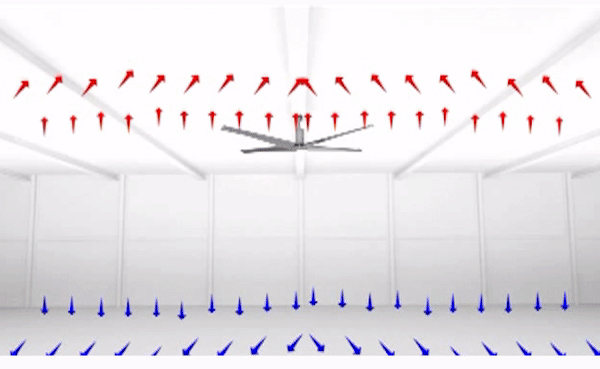- Home
- News
- Destratification: How HVLS Fans Circulate Warm Air
Destratification: How HVLS Fans Circulate Warm Air
No matter the season or the temperature-controlled application, high volume low speed fans (HVLS fans) can provide numerous benefits. Not only will they enhance environmental control to help comfort workers and protect products, they do it by using less energy with less hassle than traditional high-speed floor fans.
The Science of Destratification
When heat is introduced into a space, it settles into different temperature layers (known as strata). The warmest air is at the ceiling; the coolest is at the floor, where people work and live.
In cooler months warm air gets trapped at the ceiling and cooler air settles near the floor, creating a huge temperature variance -- especially where your team works every day. HVLS fans help destratify and create a uniform temperature by mixing the warm air with the cool air.
Reduce Energy Costs Through HVLS Destratification Fans
We already know that HVLS fans offer relief from the heat in the summer, but destratification means they also help reduce energy consumption in the winter!
Even with powerful HVAC heating systems, warm air is going to rise. HVLS fans that push warm air downward in the winter help create an even temperature from floor to ceiling.
Destratification continually mixes the air to help facility managers to provide more comfortable working environments and even cut energy usage by up to 30%.

What Does HVLS Destratification Look Like?
This illustration shows air temperatures at the ceiling starting at 91°F and 59°F at the floor. The HVLS fan quietly mixed the air and created a uniform temperature of 76°F throughout the entire space - without anyone even feeling a breeze! Just one HVLS fan can cover an area as large as 31,000 square feet!
Can’t I just Run My Fan In Reverse During the Winter?
HVLS fans are powerfully designed to operate at low speeds, pushing hot air from the ceiling downward. Since the air moves slowly, there is no perceptible draft.
While most HVLS fans can be run in reverse, they do not need to be. During the cooler months an HVLS with variable speed settings can be run between 10-15%, which will generate enough air to move the warm air to the floor, while not creating a breeze or draft.
Are HVLS Fans Right For You?
It may be surprising to hear that an HVAC system isn’t the end-all-be-all solution for efficient warming and cooling. A high-volume, low-speed (HVLS) fan network can work well independently or in combination with an HVAC system.
HVLS fans are ideal for facilities larger than 20,000 square feet and ceiling heights greater than 17 feet. How big is 20,000 square feet? To put it in perspective, it's nearly half the size of a football field.
HVLS Fans Are a Valuable Investment
Larger diameter fans will move air further down rack aisles and over obstructions. Smaller diameter fans can be most effective in specific work areas, or where installation space is limited. An Airflow Assessment prepared by a trained representative can help configure an array of fans, determining the number, size and locations that provide the maximum benefit for the investment.
We have experts ready to help! Contact us today.
Schedule Free Airflow Assessment
Related Links
Click on these links to learn more about Rite-Hite HVLS Fans: